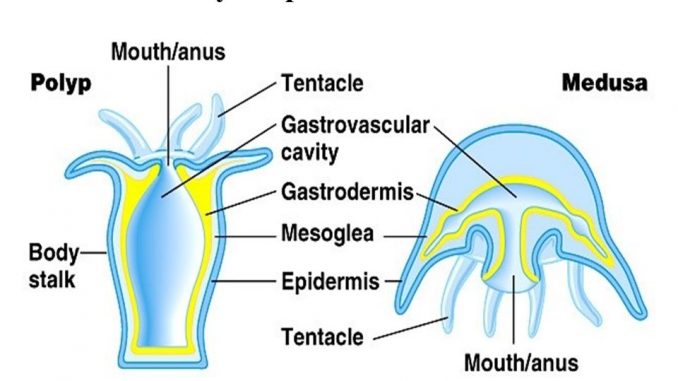
Polymorphism:
- The phenomenon of occurrence of an individual in two or more distinct morphological and functional forms.
- It occurs in the same species of an individual.
- It is also known as genetic polymorphism. For example different individuals of a species may remain separate as represented by various castes in termites, ants and Cuban snails.
- Polymorphism is an important feature of phylum coelenteratea.
- Each individual member of Coelenterates is known as Zooid and they often units to form a colony which acts as a single unit (individual).
Polymorphic form in coelenterata: two types of zooids
Coelenterates which may be single or colonial, they exists in two forms- polyps and medusa
- Polyp:
- In Hydrozoa, polyps has a tubular body with a mouth surrounded by tentacles at one end. Other end is blind and usually attached to pedal disc to the substratum
- Polyps are generally sessile
- They reproduce asexually
2. Medusa:
- In Hydrozoa, medusa has a bowl or umbrella shaped body with marginal tentacles and mouth centrally located on a projection called manubrium of the lower concave surface.
- Medusas are generally motile
- They reproduce sexually
Importance of polymorphism:
- It is essential for division of labor among the individual zooids.
- Different functions are assigned to different forms. For examples; polyps are concerned with feeding, protection and asexual reproduction whereas medusa are concerned with sexual reproduction.
Patterns of polymorphism in Hydrozoa:
Degree of polymorphism varies greatly in different group of Hydrozoa.
- Dimorphic:
- It is simplest and commonest pattern of polymorphism
- They have only two types of zooids (gastrozooids and gonozooids) and the phenomenon is known as dimorphism.
- Exhibits by many Hydrozoan colonies
- Examples: Obelia , Tubularia
2. Trimorphic:
- They have three types of zooids- gastrozooids, gonozooids and dactylzooids.
- Gastrozooids is responsible for feeding and asexual reproduction
- Similarly, gonozooids is responsible for sexual reproduction
- Dactylzooids is functionally non-feeding form and is responsible for defense.
3. Polymorphic
- Some coelenterate have more than three forms called polymorphism
- In Hydractinia, five polymorphic form or zooids exists- gastrozooids, spiral dactylzooids, tentaculozooids, skeletozooids and gonozooids.
- Gastrozooids: responsible for feeding
- Spiral dactylzooids: responsible for protection
- Tentaculozooids: responsible for sensory impulse
- Skeletozooids: responsible for spiny projections
- Gonozooids: responsible for sexual reproduction
